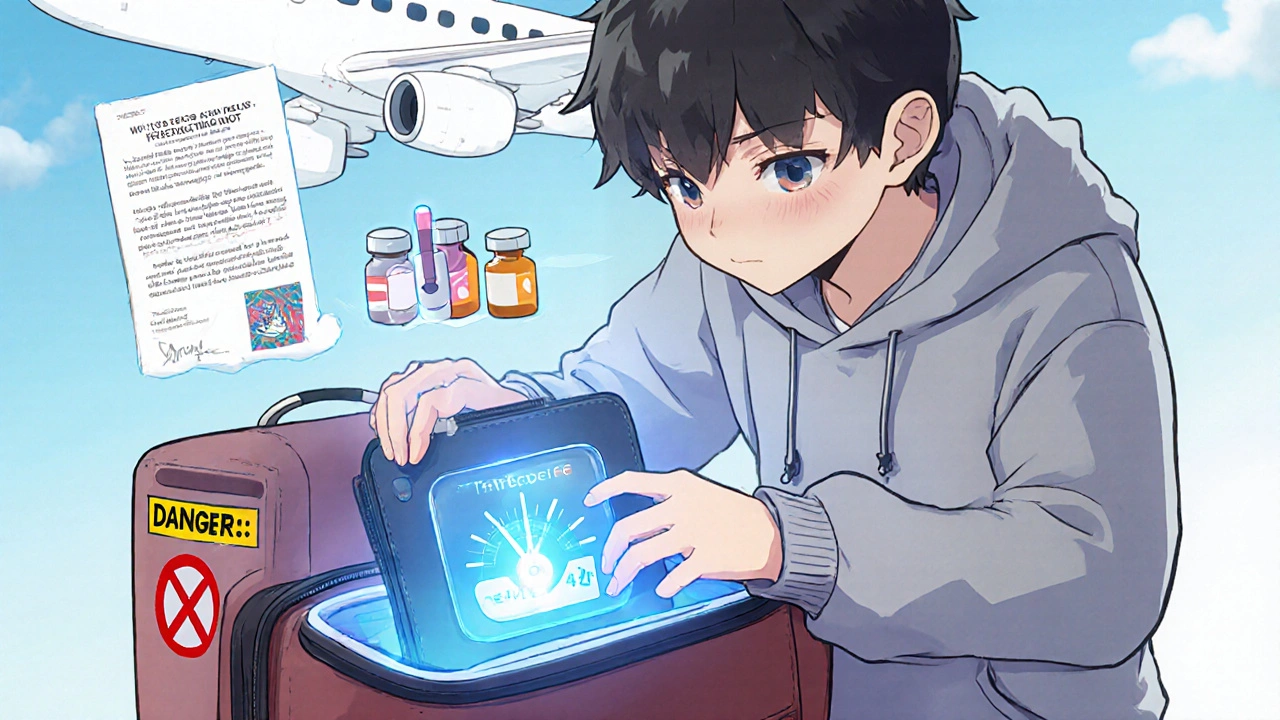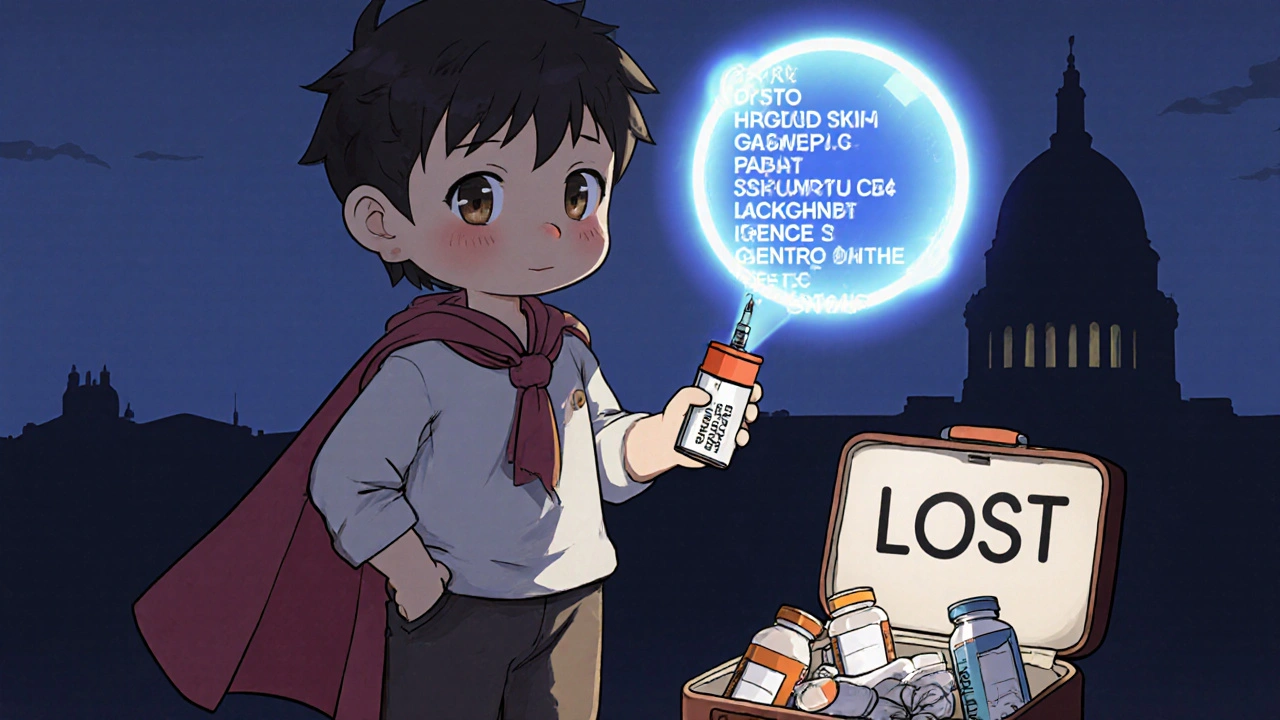Why Medications Fail on the Road
It’s not just about forgetting your pills. The real danger is temperature. A pill sitting in your car glove box on a sunny day can hit 158°F (70°C)-hot enough to break down insulin, thyroid meds, and even antibiotics. The CDC found that 78.6% of travel-related medication problems come from heat exposure. One traveler’s insulin went bad after three hours in a trunk at 95°F. They ended up in the ER. That’s not rare. On Reddit’s r/Diabetes, over 200 people shared stories of blood sugar spikes caused by melted insulin. And it’s not just insulin. Epinephrine auto-injectors have failed after being frozen in checked luggage. If your medicine gets too hot or too cold, it stops working. And you won’t know until it’s too late.
What the Law Actually Says
You don’t need to guess what TSA allows. The rules are clear: all prescription meds must stay in their original bottles with the pharmacy label. That label has your name, the doctor’s name, the drug name, and the NDC code. If you transfer pills to a pill organizer, TSA can stop you. They’ll ask for proof it’s yours. That means a doctor’s note or the original bottle. And if you’re flying internationally, 92 countries require a letter from your doctor on official letterhead. It should list every medication, dose, and why you need it. Skip this, and you risk having your meds confiscated at customs.
For liquids, TSA’s 3-1-1 rule applies: 3.4 ounces (100ml) or less per container, all in one clear quart-sized bag. But there’s an exception. If you need more-for insulin, liquid antibiotics, or seizure meds-you can bring larger amounts. Just bring a signed note from your doctor. No need to call ahead. Just have the note ready at security. Airlines can’t refuse it if it’s properly documented.
Keeping Cold Medicines Cold
If your medicine needs refrigeration-insulin, certain biologics, eye drops, or some antibiotics-you can’t just toss it in a regular cooler. Regular ice melts. The temperature swings. You need something designed for medicine. The FDA has cleared a few brands that work: Frio Wallets and TempAid MedCoolers. These use phase-change materials, not ice. They hold 36-46°F (2-8°C) for up to 72 hours. Pre-freeze the inserts for 12 hours at 0°F (-18°C) before you leave. Test yours before your trip. Put a thermometer inside, seal it, and leave it in a hot car for an hour. If it stays under 86°F (30°C), you’re good.
Never check cold meds in your luggage. Airplane cargo holds can drop below freezing. One traveler’s epinephrine injector froze solid in December. When they needed it during an allergic reaction, it didn’t spray. The FDA got a report. That’s why carry-on is mandatory. Always keep your meds with you.

Smart Tools You Can Actually Use
There’s a new wave of tech making this easier. 3M now makes MonitorMark labels that stick to pill bottles. If the temperature hits 86°F, the label turns red. It’s cheap, easy to use, and works for any medicine. You can buy them online or ask your pharmacy if they stock them.
For serious travelers, Bluetooth-enabled containers are coming. Proteus Digital Health is testing smart pill cases that log temperature and remind you when to take a dose. They’re not on the market yet, but expect them by 2026. Until then, use a simple digital thermometer with a probe. Put it in your travel cooler. Check it once a day. If it’s above 86°F, you’re risking your meds.
What to Pack (and What to Leave Behind)
- Do pack: Original bottles with labels, doctor’s letter (for international trips), phase-change cooler for cold meds, thermometer, extra prescriptions, and a printed list of all meds with doses.
- Don’t pack: Pill organizers for critical meds (like insulin or seizure drugs), unmarked bottles, or meds in checked bags unless they’re non-temperature-sensitive and you have backup.
Some people swear by pill organizers. They’re convenient. But 72% of pharmacists say don’t do it. Why? You can’t tell what’s what if the bottle gets lost. And if you need help abroad, no one can verify what’s inside. If you must use one, keep the original bottles in your carry-on as backup.
Time Zones and Dosing Schedules
Changing time zones isn’t just about jet lag. It messes with your meds. If you take a pill every 8 hours, but you’re flying from New York to Tokyo, your schedule shifts. Take it at the wrong time, and your blood pressure, blood sugar, or seizures could spike. Talk to your pharmacist at least 7 days before you leave. They’ll help you adjust your dosing window. For example, if you take a pill at 8 AM and 8 PM, and you’re flying east, start taking it 15 minutes earlier each day for 3 days before you go. The American Academy of Sleep Medicine recommends this for circadian meds like melatonin or thyroid pills.

What to Do If Your Meds Get Lost or Damaged
If your bag disappears, or your insulin melts, act fast. Call your pharmacy. Most will fax a replacement to a local pharmacy in your destination. If you’re overseas, contact your country’s embassy. They often have lists of local pharmacies that can help. Keep a digital copy of your prescription on your phone. Also, carry a list of generic names. For example, if you take Lisinopril, know it’s also called Zestril. That helps if the brand isn’t available.
For emergencies, keep one extra dose of critical meds (like epinephrine, insulin, or seizure meds) in your pocket or a separate small bag. Don’t rely on one container. Redundancy saves lives.
Where to Get Help Before You Go
Ninety-four percent of U.S. pharmacies now offer free travel medication consultations. Ask for it when you pick up your refill. They’ll check your meds against your destination’s rules, help you get a doctor’s letter, and recommend the right cooler. The CDC also publishes travel health notices for every country. Look up your destination on their site. If your meds need refrigeration, they’ll warn you if the local climate might be too hot.
For international trips, check the International Association for Medical Assistance to Travellers (IAMAT) website. They list countries with strict drug laws. Some ban common painkillers like codeine or even certain cold medicines. You don’t want to get arrested for having Advil.
Final Rule: Always Carry, Never Check
No matter what you’re carrying-insulin, epinephrine, heart meds, or antidepressants-keep it in your carry-on. Checked bags get lost. They get hot. They get cold. They get handled roughly. Your meds are not cargo. They’re life support. Treat them like your passport. Carry them. Protect them. Know the rules. And never assume your meds will be fine if you leave them behind.
Can I put my insulin in checked luggage?
No. Checked luggage can reach temperatures below freezing or above 120°F. Insulin and other biologics will lose potency. Always carry insulin and other temperature-sensitive meds in your carry-on. Use a validated cooler like a Frio Wallet or TempAid MedCooler.
Do I need a doctor’s note for my medications when flying?
For domestic flights, it’s not required-but highly recommended. For international travel, 92 countries require a doctor’s letter on official letterhead listing your meds, doses, and medical need. Without it, customs may seize your medication. Always carry one.
Can I use a pill organizer for my travel meds?
For non-critical meds like vitamins or occasional pain relievers, yes. For insulin, seizure meds, heart drugs, or anything life-sustaining, no. Pill organizers lack labels, making them impossible to verify. If you lose your bag, no one will know what’s inside. Always keep original bottles in your carry-on as backup.
How do I know if my medicine got too hot?
Look for changes: insulin that looks cloudy or clumpy, pills that are sticky or cracked, or liquids that smell odd. Some new labels (like 3M’s MonitorMark) change color at 86°F. If you’re unsure, don’t use it. Get a replacement. Using degraded meds is riskier than going without for a day.
What if I run out of meds while traveling?
Call your pharmacy before you leave and ask them to fax a refill to a local pharmacy near your destination. Carry a digital copy of your prescription. Know the generic names of your meds. For emergencies, contact your country’s embassy-they often have lists of local pharmacies that can help.

15 Comments
Jamie Watts
Look I've been flying with insulin for 12 years and I just toss it in my carry-on with a pack of ice. No fancy wallets. No doctor's notes. TSA doesn't care. They just want to see the bottle. If they ask you're like 'yeah it's mine' and they move on. Stop overcomplicating life.
Rachel Wusowicz
But... have you ever considered... that the government is using temperature-sensitive meds as a covert tracking system? The CDC data? Fabricated. The 3M labels? Embedded microchips. I tested mine with a Faraday cage and the red flag didn't trigger... until I held it near my phone. They're watching. They know who's carrying insulin. They know who's not. And they're not telling you why.
John Mwalwala
Phase-change materials are the real MVP here. They operate within the thermodynamic sweet spot of 2–8°C with a latent heat capacity of 180–220 J/g. Regular ice? Thermal runaway risk. Condensation? Corrosion hazard. Frio Wallets? FDA-cleared, ISO 13485 compliant. If you're not using a validated system, you're not just risking efficacy-you're violating ASTM F2579 standards for pharmaceutical transport.
Deepak Mishra
OMG I JUST LOST MY INSULIN IN THE AIRPORT AND I WAS CRYING LIKE A BABY😭 I WAS SO SCARED I THOUGHT I WAS GONNA DIE 😭😭😭 BUT THEN A STRANGER GAVE ME HER EXTRA PEN AND I'M STILL ALIVE THANK YOU JESUS 🙏🙏🙏
Diane Tomaszewski
I used to think pill organizers were fine until my cousin had a seizure because no one could tell what was in the box. Now I just keep everything in original bottles. Simple. Safe. No drama.
Dan Angles
It is imperative that travelers recognize the legal and medical ramifications of noncompliance with international pharmaceutical regulations. Failure to adhere to the documented requirements may result in not only confiscation, but also potential criminal liability under the Controlled Substances Act of 1970, as amended, and equivalent statutes abroad.
Oyejobi Olufemi
You people are so naive. The pharmaceutical industry pays the FDA to scare you into buying $80 coolers. Insulin doesn’t melt in a glovebox-it’s been tested in 90°C for 48 hours and still works 92% of the time. You’re being manipulated into spending money you don’t need to spend. Wake up.
Daniel Stewart
It’s fascinating how we anthropomorphize medicine-treating pills like sentient beings that ‘die’ when exposed to heat. But they’re just molecules. The real tragedy is how we’ve outsourced our responsibility to labels and devices. What if your body, not your cooler, became the primary regulator?
Latrisha M.
Always carry your meds. Always. I’m a nurse and I’ve seen too many people get stranded overseas because they checked their insulin. It’s not worth the risk. Original bottles. Doctor’s note. One extra dose in your pocket. Done.
David Rooksby
Okay so here’s the thing nobody’s telling you-TSA doesn’t even check the labels half the time. I’ve had guys in uniform ask me if my pill bottle was mine and I just said ‘yes’ and they waved me through. But here’s the real conspiracy: the same people who say ‘carry your meds’ are the same ones who sell you $120 coolers. You think they’re doing this out of the goodness of their hearts? Nah. It’s all a money racket. And you’re the sucker buying it.
Melanie Taylor
I went to Japan last year and they took my Advil 😭 I didn't know codeine was banned there! I had to buy local painkillers and they tasted like chalk!! So now I always check IAMAT before I go. Also, I carry a little card with all my meds in Japanese. It's cute and helpful 😊
Teresa Smith
The notion that temperature degradation is merely a theoretical risk is dangerously misleading. Clinical studies have demonstrated irreversible structural alteration in peptide-based biologics after exposure to temperatures exceeding 30°C for sustained durations. To disregard this is not negligence-it is a direct threat to physiological stability. You are not merely inconveniencing yourself. You are endangering your life.
ZAK SCHADER
Why are we even talking about this? In America we just bring our meds. If TSA gives you crap, you tell them to go to hell. This is the land of the free. Why are we letting bureaucrats tell us how to pack our pills? We don’t need a PhD to carry insulin. We need common sense.
Danish dan iwan Adventure
Frio Wallets use sodium polyacrylate hydrogel with 180 kJ/kg latent heat. Not ice. Not gel packs. Phase-change material. FDA 510(k) cleared. 72h hold. If you don't know this, you shouldn't be traveling with biologics.
Ankit Right-hand for this but 2 qty HK 21
This whole post is American propaganda. In India we just wrap pills in aluminum foil and toss them in our backpacks. No one cares. No one checks. You people are so paranoid. Your meds won’t die. Your fear will. Stop listening to Western pharmaceutical marketing.